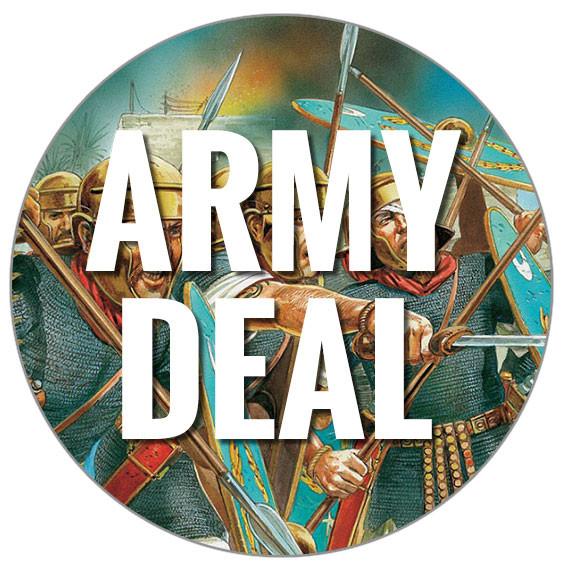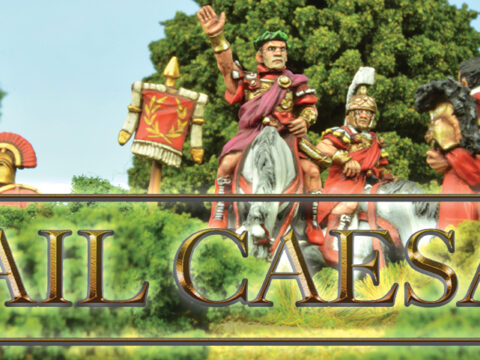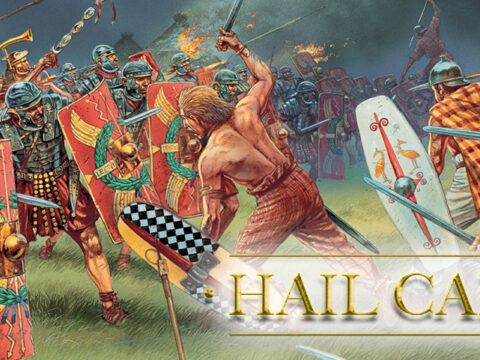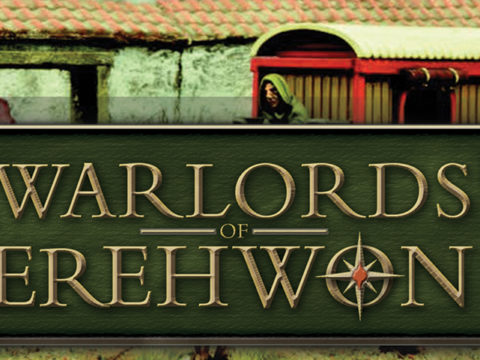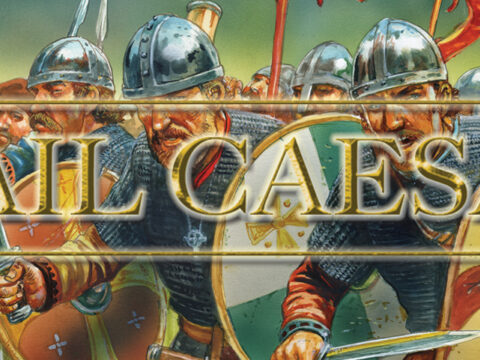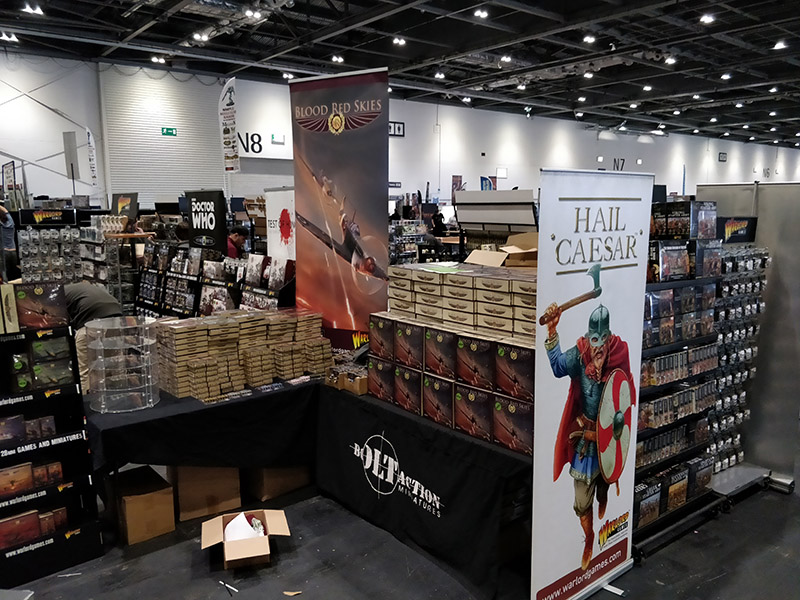This article, by Dr Phil Hendry, aims to dispel the myth that the Roman war machine was all about the much-lauded Legionary and that Auxiliary units were bit part players. Over to you, Phil…
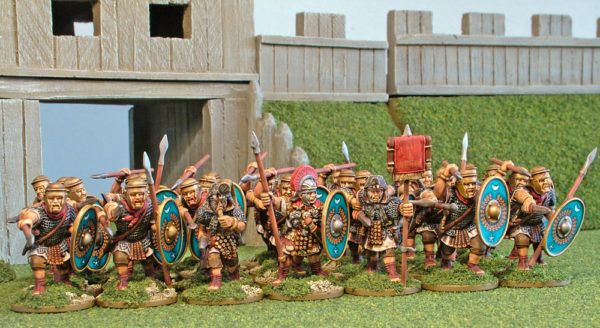
Phil: The aim of this article is to show that Auxilia are much better troops than most wargamers believe them to be. We will examine the reasons wargamers have for believing that they are so inferior and examine the reality, as far as we know it, of the Auxilia – their nature, the structure of their units, and why wargamers need them.
There are a number of misconceptions regarding the nature and employment of the Auxilia. These include:
- the inferiority of the auxilia, in both training and equipment, when compared to the legions;
- that the legions were heavy infantry, whilst the auxilia provided only light troops;
- that the main battle-line was the preserve, exclusively, of the legions, being supported on the flanks by the light troops of the auxilia (this would make sense if (ii) above were true – however, as we shall see, it is not);
- auxilia were only support troops, incapable of mounting independent operations themselves, only ever helping the legions;
- the auxilia were border troops, manning frontier forts, whilst the legions provided a ‘strategic reserve’, being based well back from the frontier, and only intervening in the event of a major invasion which the auxilia could not repel unaided.
Most of these misconceptions stem from a too-literal reading of ‘De Re Militari’ (also known as ‘Epitoma rei militaris’) by Publius Flavius Vegetius Renatus (hereafter referred to as ‘Vegetius’). The author of this work wrote sometime after the death of Emperor Gratian (383AD). It seems likely to have been written in the reign of the Emperor Theodosius I, who reigned from 379 to 395.
Vegetius is the only ‘manual’ of the Roman military to have survived ‘intact’. However, we should note that, firstly, Vegetius himself had no military experience whatsoever, and secondly, that his work is a carelessly constructed compilation of material from a vast range of sources and periods, all jumbled together. As such, it is very hard to ‘unscramble’ it enough to make sense of it and to decide which parts are relevant to which era.
Let us take each of the misconceptions in turn, and see what we make of them.
- The only evidence we have for the auxilia being inferior, stems from: (a) comments in Vegetius – (written much later than our period, and containing all sorts of concepts, from all sorts of periods, all mixed up, making it frustratingly difficult to interpret), in which he says that young men preferred to join the auxilia in order to escape the harsher discipline and training of the legions; (b) from the reliefs of Trajan’s column, which was erected to extol the glory of Trajan and his legions in the wake of the hard-fought, but ultimately successful, campaigns in Dacia. To me it is a pure recruiting poster: bung up a darned great monument to the legions, showing their triumphant victory, so as to say to the citizens: ‘join the army and kick barbarian butt’. The auxilia very much play second fiddle to the legions on the column but, I contend, this has nothing to do with reality, and everything to do with propaganda. There’s very little, if any, evidence from the archaeology that the auxilia were trained or equipped in an inferior fashion. If they really were so inferior, why were they paid as much as 4/5 of legionary pay, despite not being Roman citizens? The Romans weren’t stupid!
- This again stems largely from Trajan’s column and is down to the ‘convention’ that legionaries are shown in lorica segmentata, whilst auxiliaries aren’t, and that legionaries are shown with the large rectangular scutum (most suitable for fighting in close formation), whilst auxilia are shown with oval shields. Vegetius also does his best to mislead us: “auxilia are always joined as light troops with the legions in the line”. It is true that some specialist units in the auxilia, such as Syrian archers and Numidian cavalry, wore light armour (or none). But they were a small minority of the auxilia. Most auxiliary cohorts contained heavy infantry similar to legionaries – wearing mail and helmets, carrying spears and large shields (though, possibly, oval as opposed to rectangular).
- This is plainly not true – there were a number of battles, Mons Graupius (somewhere in Northern Scotland, where the Romans defeated the Caledones) being a case in point, where the legions stood back and let the auxilia get on with it – most of them were, after all, equipped as heavy infantry, so why not use them in the role for which they were equipped? And for them to form part of the main battle line would be a continuation of the practice during the Republic, when the Citizen legions formed up in the centre, flanked by the ‘Socii’ (allies), who were essentially armed and equipped in the same manner as the Citizens – and are the precursors of the auxilia.
- See (iii) above. Roughly twenty major battle scenes are shown on Trajan’s column. Despite the column’s seeming bias against the auxilia, they take part in nineteen of these, and in twelve they are unaccompanied by legionaries.
- There is no shortage of evidence for the presence of legionaries on or near the frontiers. It has to be said that in Britannia the legionary bases were well back from the frontier (unlike, for example, Germany), but vexillations (detachments) often seem to have been on or near the frontier. And if you insist that only the legionaries wore lorica segmentata, well, bits of the stuff turn up very frequently in digs on auxiliary forts where it clearly shouldn’t be found. Of course, this latter point could be taken the other way too – perhaps auxilia did wear lorica segmentata after all!
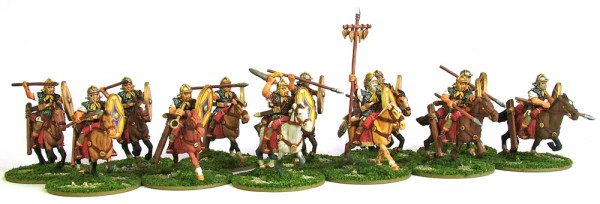
In conclusion, there were few significant differences in training, fighting capability or tactical role between legionary infantry and their auxiliary counterparts – it seems as though either could fight in the main battle- line or act as light infantry. I suspect that the auxiliaries were often given the ‘dirty jobs’ where taking a few casualties wouldn’t matter (it was probably bad form to get citizens killed unnecessarily). The legions, on the other hand, were more or less guaranteed to be reliable and would be used where success was imperative, regardless of casualties.
In cavalry, auxiliaries were superior, as they were combat-capable, whereas it seems that the small contingent of legionary cavalry were not (they seem mostly to have served as messengers). In archery, legions seemingly had no capability at all.
When it comes to rates of pay, it seems that the auxilia weren’t all that much different to the legions – in mid First Century AD, an auxiliary infantryman was paid 180 denarii per annum, whilst legionary infantryman received 225. The Romans weren’t stupid and I can’t see them paying 4/5 of a legionary salary to a soldier who is markedly inferior to his legionary counterpart.
In view of this, it seems clear to me that the auxilia are worthy of further study, and worthy of a more prominent place in our armies of little men. So, let us consider the auxilia, their organisation, and how and why this might be different to the legions.
Organisation
Unlike the legions, which were monolithic structures of 5,000 men, all more or less alike, the auxilia were organised in smaller units, of several different kinds. The easiest way to explain the differences is probably in tabular form – see opposite.
| Unit Type | Service | Unit Commander | Sub-unit Commander | No of sub-units | Sub-unit strength | Unit strength |
|---|---|---|---|---|---|---|
| Ala quingenaria | cavalry | praefectus | decurio | 16 turmae | 32* | 512 |
| Ala milliaria | cavalry | praefectus | decurio | 24 turmae | 32 | 768 |
| Cohors quingenaria | infantry | praefectus | decurio | 6 centuriae | 80 | 480 |
| Cohors milliaria | infantry | tribunus militum* | centurio | 10 centuriae | 80 | 800 |
| Cohors equitata quingenaria | mixed infantry/cavalry | praefectus | centurio (inf), decurio (cav) | 6 centuriae, 4 turmae | 80, 30 | 600 (480inf/120cav) |
| Cohors equitata milliaria | mixed infantry/cavalry | tribunus militum* | centurio (inf), decurio (cav) | 10 centuriae, 8 turmae | 80, 30 | 1,040 (800inf/240cav) |
* There is some debate about the strength of the turma between 30 and 32 men. 30 was the size of a turma in the Republican cavalry and in the cohors equitata of the Principate (early empire) auxilia. Against this is a statement by Arrian that an ala was 512 strong. This would make an ala turma 32 men strong. Personally, I suspect it simply comes down to whether one counts the commander and standard bearer, or just the troopers, in the total.
** Batavian and Tungrian cohortes milliariae seem to have been commanded by a praefectus
As can be seen from the table, there are several different kinds of units. Superficially at least, the infantry cohorts resemble those of the legions – in particular the cohors quingenaria are very similar to the ordinary cohorts of the legions except that the legionary cohort seems not to have had an overall commander – meaning that it was not capable of independent action, unless the legate appointed ‘someone’ to take command – perhaps one of the tribunes or a senior centurion?
If one examines the deployment of auxiliary units, it can easily be seen that it was rare to deploy units from the same province together. It was also the aim that units wouldn’t serve in their own province. This was intended to reduce the chance of rebellion: if the biggest formation in any given province was a Roman legion, it was likely to prevail in the case of any of the auxiliary units revolting.
Of course, a lot of auxiliary units recruited new troops in the provinces they were stationed in, as well as (sometimes?) receiving some from their ‘home’ province, so the original ethnic character gradually became diluted. To these pools of recruits can be added the sons of the veterans.
Soldiers were not, officially, allowed to marry, but it seems that a lot did. When (if!) they completed their service and were discharged, they automatically became Roman citizens, as did their children (but not their wives!). Being citizens, their sons would be eligible to join the legions, rather than the auxilia, but many seem to have joined their father’s former unit. Thus the auxiliary units were not purely made up of non-citizens. Of course, the officers (tribunes, prefects, centurions and decurions) were usually Roman citizens.
The Auxilia in Britannia
Britannia was perhaps the most ‘militarised’ of any province – at any given time it had a garrison of about 10% of the entire Roman army. The ‘Brittunculi’ must have been really horrid!
In addition to either three, or (sometimes) four, legions (the number varied a bit over the years, but was never less than three) there were up to about fifty units of auxilia in the province – for instance, in 130 AD, we think that there were 11 cavalry alae (one of which was a milliary ala), and 45 cohorts (of which 11 were milliary) – of course, some of the latter were infantry, and some were mixed units. Numbers-wise then, any army in Britain is likely to consist mostly of auxilia.
A minor point on ethnicity and the naming of units – it doesn’t necessarily follow that a unit entitled ‘The Fourth Dacian Wing’ actually had any connections with Dacia whatsoever. Dio Cassius describes how a cavalry unit was formed with the title ‘Batavians’, simply on the basis that Batavians had a reputation for superb horsemanship – there isn’t a shred of evidence that any Batavians ever actually belonged to it.
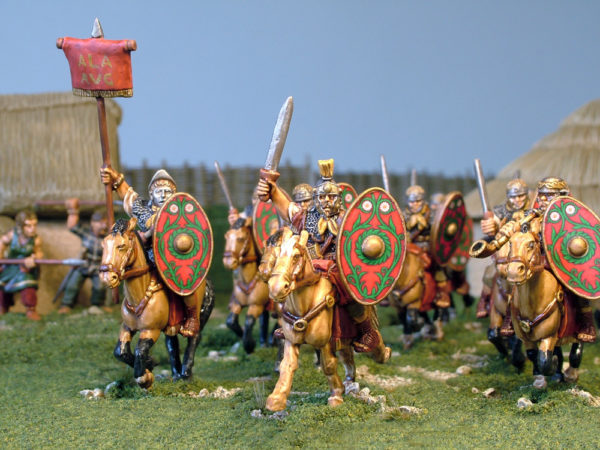
Specialised Units
In addition to the regular auxiliary units, there were a number of units which had particular functions. In the days of the Roman Republic, there were just three types: Balearic slingers, Cretan archers and Numidian light cavalry.
During the Principate, this increased to include other specialised types:
Sagittarii (archers) – alae sagittariiorum (mounted archers), cohors sagittariiorum and cohors sagittariiorum equitatae (mixed mounted and foot archers) – just one unit is listed for Britannia, The First Cohort of Hamian Bowmen;
Equites Maurorum (Moorish horsemen), though how many units of these fought in their traditional ‘barbaric’ fashion, and how many fought, and dressed, as ‘regular’ auxiliary cavalry is unknown;
Funditores (slingers) – oddly, no record of any units is known from the Principate, though slingers are depicted on Trajan’s Column;
Dromedarii – camel-mounted units: just one of these is attested from the 2nd century, ala I Ulpia dromedariorum milliaria in Syria, but surely there must have been more to patrol the deserts of Arabia and North Africa;
Exploratores – reconnaissance units (from explorare – to scout) – examples include two numeri exploratorum attested in the 3rd century in Britain: Habitanco and Bremenio (both names of forts).
Irregular Units
Throughout the Principate period, there is evidence of ethnic units of barbari outside the normal auxilia organisation fighting alongside Roman troops. The gradual inclusion of greater numbers of this sort of troops into the military was taken a further step by the creation under Hadrian (who reigned 117-138 AD) of a new type of force in addition to the legions and auxilia, known as numerii. Formed in bodies of around 300 irregular troops, the numerii were drawn largely from the peoples of client-states – i.e. ‘allied’ states from beyond the borders of the empire, as well as more ‘barbaric’ peoples from within the empire. They were both less regimented and less Romanised than normal auxiliary troops, with a “pronounced national character”, including native dress, native war cries, and being led by their own leaders. The introduction of the numeri was a response to the need for cheap troops, who were nevertheless fierce and provided a force balance of light infantry and cavalry. In wargames terms, using a unit or two of troops who would normally be seen as ‘enemies’ would fit the bill admirably.
Get yourself some auxilia (or numerii!) – it’s the perfect excuse to relieve the (elite) monotony of wall-to-wall legionaries! Variety is the spice of life and all that. Seriously though, the Romans used auxilia, and if we want to be true to the period, so should we. In my view, they don’t just add colour, they also make your army more capable – without them you’re not going to have much in the way of cavalry, light infantry or missile-armed troops.
Finally, a throw-away remark someone made about the First Cohort of Hamian Bowmen made me think for a moment. It’s not clear quite why the garrison of Hadrian’s Wall should include a unit of archers. Someone suggested that perhaps they were stationed there to provide a source of fresh meat for the rest of the garrison by hunting. If this was the case, then presumably a few would be stationed at each fort – maybe this is why an archer’s tombstone was found at Vercovicium (Housesteads) on Hadrian’s Wall, when they were actually based at Magnis (Carvoran) on the Stanegate.
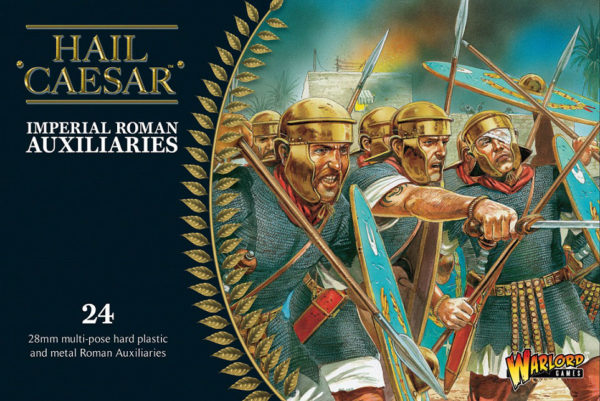
As you can see we have plastic multi-part Roman Auxilia and they come with a stunning metal command group of Centurion, Optio, Cornicen and Signifer.
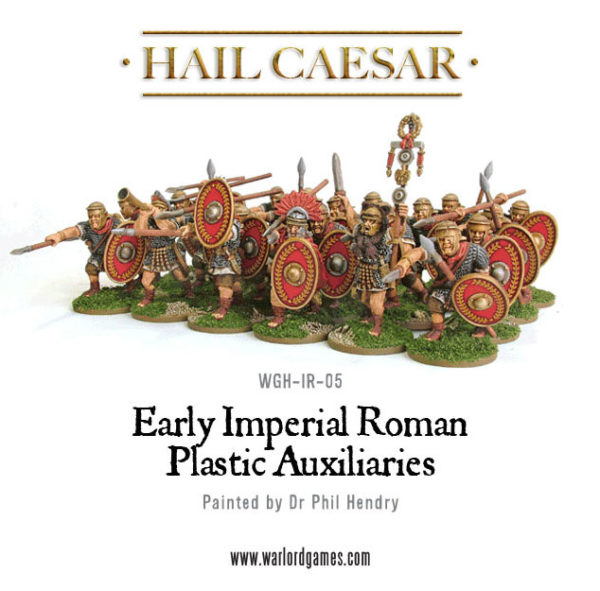
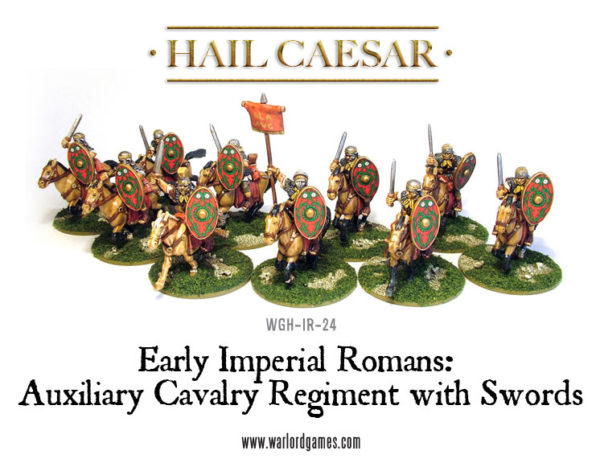
We also have a set of Roman Auxiliary horsemen armed with swords. These brave cavalrymen also come with sheaths of javelins. The helmets are of a different style to those armed with spear above so you can field two very distinct units.
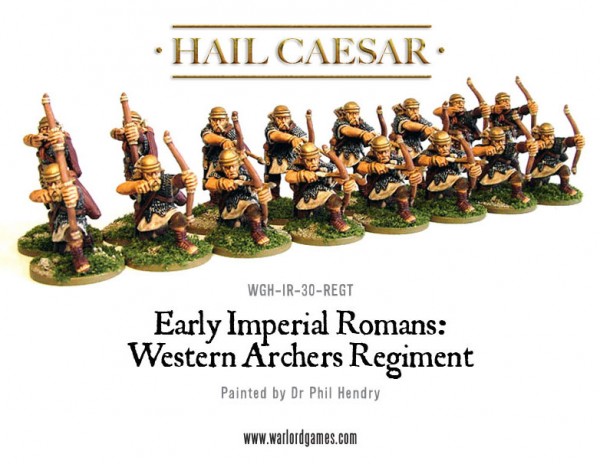
Giving your army missile capability is another facet of the Auxiliary’s flexibility. We have two types of Auxiliary archers available – the Western Archers, dressed in traditional Roman gear above…
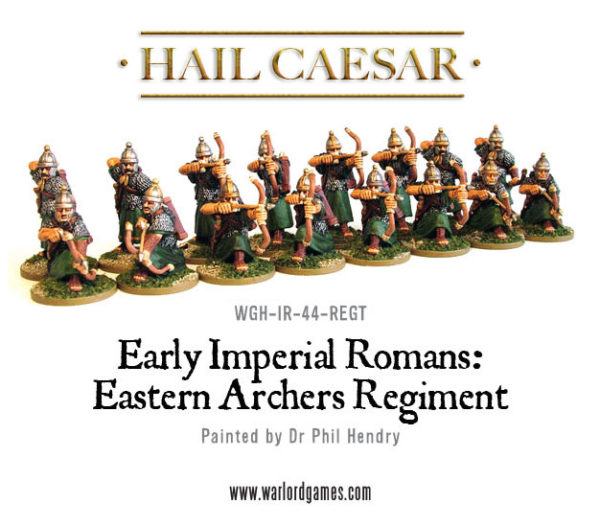
…or the Eastern Archers who don the garb of their homeland – conical helmets and long robes under their chainmail. They also differ from their Western counterparts in using thumb-rings to draw their arrows rather than grasping them between forefinger and them.
Or grab this Auxiliary Roman Force!
